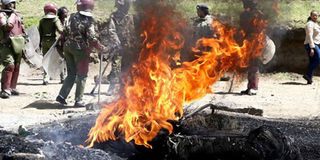It is easier to prevent than manage conflict

Residents of Mercy Njeri in Rongai, Nakuru County, on December 3, 2016 block the Nakuru-Kabarak road protesting the killing of two people. In order for us to create a culture of conflict prevention, all institutions must move away from a culture of reaction to one of prevention. PHOTO | SULEIMAN MBATIAH | NATION MEDIA GROUP
What you need to know:
- Conflict prevention is a set of instruments used to prevent or solve disputes before they have developed into active conflicts.
- It is far easier to change the mode of interaction from destructive to constructive in an early rather than late phase.
Africa is the youngest continent on the planet with 60 per cent of the one billion people here being under the age of 35 years.
Lately, we have increasingly seen young people play a big role in transforming the political and social state of the continent.
Occasionally, they have been used by political leaders to engage in violence against their opponents.
Many political leaders view them as instruments of their continued stay in office.
PREVENTING CONFLICTS
The power of youth in political matters cannot, therefore, be ignored.
Many institutions see little or no point in pursuing conflict prevention, mostly viewed as a waste of resource applying the old saying “why fix it when it is not broken”.
This is the same as saying “why buy insurance if you are not sick”.
The simple answer is that when you need the insurance, it is too late to get it.
We are alive to the fact that not all potential conflicts can be prevented.
Our argument is that early prevention will decrease the amount of conflicts that will escalate to unstable peace or war, thereby preventing human suffering and saving economic capital.
ELEMENTS OF CONFLICT
Legitimising huge costs to prevent potential conflicts that have not yet reached a critical level has always been the greatest challenge for many institutions.
Spending more money once an open conflict has started has always been viewed as the easier route.
Conflict prevention is a set of instruments used to prevent or solve disputes before they have developed into active conflicts.
Conflicts should not be defined simply in terms of violence (behaviour) or hostility (attitudes), but also include incompatibility or “differences in issue position”.
An author by the name Mitchell suggests that conflict consists of three parts: attitudes, behaviour and situations that interact and create conflicts between actors.
CONFLICT CYCLE
Conflict is not a static situation, but a dynamic one where the intensity level changes over a conflicts’ life cycle.
An understanding of the conflict cycle is essential for an understanding of how, where and when to apply different strategies and measures of conflict prevention and management.
Conflicts are described as cyclical in regard to their intensity levels, escalating from (relative) stability and peace into crisis and war, thereafter de-escalating into relative peace.
This cycle is important, especially during electioneering time.
Conflict prevention can either be direct prevention or structural prevention.
Direct conflict prevention is about measures aimed at preventing short-term, often imminent, escalation of a potential conflict.
PARADIGM SHIFT
Structural prevention is about putting long term measures that address the underlying causes of a potential conflict.
In Kenya, we must ensure that the economic development structural prevention attempts by the government work and have direct outcomes that can be measured to showcase how they are changing the lives of the youth.
Measures such as military disarmament can have both structural and direct effects on the youth like what we have witnessed in pastoral communities.
In order for us to create a culture of conflict prevention among the youth in Kenya, all institutions, whether government, religious or NGOs, must move away from a culture of reaction to one of prevention.
They must analyse the causes and dynamics of conflict and peace in order to understand how their actions will affect the stability of the country.
They must understand how their objectives, design and implementation may interact with the political and economic dynamics in the society.
When conflict has been militarised, the political and economic cost to solve or manage it escalates quickly.
It is far easier to change the mode of interaction from destructive to constructive in an early rather than late phase.
Dr. Kellen Kiambati is a management consultant [email protected]; Dr Anne Muriuki is a social scientist and management consultant.




